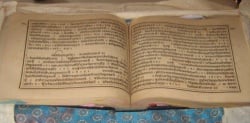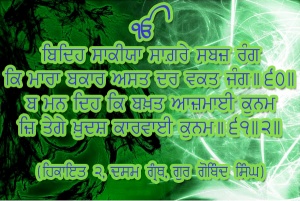Hikayat
- PREREQUISITE: Thorough study of Guru Granth Sahib
| Sri Dasam Granth Sahib (ਦਸਮ ਗ੍ਰੰਥ ਸਾਹਿਬ) |
| Banis |
| Jaap - Akal Ustat - Bachitar Natak - Chandi Charitar Ukat(i) Bilas - Chandi Charitar 2 - Chandi di Var - Gyan Parbodh - Chobis Avatar - Brahm Avtar - Rudar Avtar - Sabad Patshahi 10 - 33 Swaiyey - Khalsa Mahima - Shastar Nam Mala - Ath Pakhyan Charitar Likhyate - Zafarnama - Hikayats |
| Other Related Banis |
| Bhagauti Astotar - Ugardanti - Sri Kaal Chopai - Lakhi Jungle Khalsa - Asfotak Kabits - Sahansar Sukhmana - Vaar Malkauns Ki - Chandd Patshahi 10 |
| History |
| Historical Sources - Memorials - Anti Dasam |
| Philosophical aspects |
| Idol Worship - Pilgrimages - Chandi - Triya - Shastar |
| Scholar Views |
| Singh Sabha Lahore - Bhai Kahn Singh Nabha - Professor Sahib Singh - Bhai Veer Singh - Jarnail Singh Bhindrawale - |
| Critics |
| Ram Raaiyas of Payal - Teja Singh Bhasod - Gyani Bhag Singh Ambala - Professor Darshan Singh |
Hikayat or Hikayataan (not a separate title in the Dasam Granth) is a famous name for the eleven tales composed in Persian verse, written in Gurmukhi by Guru Gobind Singh, as part of the Zafarnamah.
The title `Hikayat` does not occur in the actual text, but most of the tales have a verse, coming after two or three lines, which contains the phrase Hikaayat shumdem. Hikayataan, being the plural of Hikayat (story, tale), is adopted as the title for these tales.
Since Persian was the language of the Mughal Court, Guru Gobind Singh wrote the Zafarnamah in Aurangzeb's language, adding the Hikayats in same language. Guru Gobind Singh was well versed in Persian; the tales are in keeping with the literary taste and style of medieval India, ranging from the romantic and chivalrous to the fantastic and the macabre.
Historical Resources about Hikayats
According to Sikh Historical resources, Parchi Patshahi Dasvin(Sevadas, 1741)[1] and Gurbilas Patshahi 10(Kuir Singh, 1751),[2] Hikayats were composed by Guru Gobind Singh at Dina Kangar, Punjab and is part of Zafarnamah which was sent along with Zafarnama. Koer Singh believes that Guru Gobind Singh had written 12 hikayats in Zafarnama.[3] In Sakhi 13, Sevadas mentioned that Guru Gobind Singh had written fables of many kings and also mentioned his own history in zafarnama.[4]
Tradition holds that Guru Gobind Singh composed and added the Hikayats in an effort to have Aurangzeb realize the folly of breaking his oath sworn on the Quran, hoping as well to improve the Mughal ruler's decision making ability. To rely on facts and check on the activities of his personnel. Gyani Narain Singh, one of interpreters of Dasam Granth also had the same view.
Relation with Charitropakhyan
Many of these tales are the Persian translations of the narratives in Charitropakhyan which serves as an additional proof of single Authorship of both compositions [5]. Six of these eleven tales are Hindi tales retold in Persian:
- Hikayat 4 is Chritra 52 of the Chritropakhyan, where an intrepid ran defeats the obdurate Raja Subhat Singh in battle in order to marry him.
- Hikayat 5 is the Persian version of Chritra 267. Some other stories from Charitropakhyan have likewise found their way into these hikayat.
- Hikayat eight is the counterpart of Charitar 118.
- Hikayat eleven is one of Charitar 246:

|
ææ Beginning ææ Hikayat 2 ææ Hikayat 3 ææ Hikayat 4 ææ Hikayat 5 ææ Hikayat 6 ææ Hikayat 7 ææ ææ Hikayat 8 ææ Hikayat 9 ææ Hikayat 10 ææ Hikayat 11 ææ Hikayat 12 (End of Zafarnamah)) ææ |
Information
- The last section of the Dasam Granth, a part of Zafarnama, are the Hikayats which are in the Persian language.
- There are eleven Hikayats in total covering 28 pages.
- The Persian used is said to be very good, and all are rhymed. They are supposed to contain moral instruction for the Emperor Aurangzeb.
- Each of the eleven stories opens with praises to god, and ends with a command to the cup-bearer to bring a cup of wine, usually green, possibly a play on the name of Hari, which means green With these artistically styled poems with their Sufi colouring, the Dasam Granth ends.
- Hikaytan were added to zafarnamah to give shame to Aurangzeb that even women are better than him. Through these Hikayats Guru Gobind Singh told that even woman is brave than aurangzeb. These stories disgrace or Dishounour Aurangzeb so that he realize that he was wrong.
Summary of the Hikayats in Zafarnamah
Hikayat 1 - Tale of Guru Gobind Singh and King Aurangzeb
In the Dasam Granth, the Zafarnama is numbered one and the last story twelve, making them all parts of the Zafarnama and keeping the Persian section as a unit.
Hikayat 2 - Tale of King Daleep and his four Sons
Hikayat number two is about the Raja’s four sons who were tested to determine their fitness to rule. The three elder sons were given thousands of elephants, horses and camels. These they lost or squandered away. The youngest son was given a kernel and a half of gram which he planted, and from the harvest he was able to buy thousands of elephants, horses and camels, and to build cities of Delhi and Mungipatam besides. The moral seems to be the wisdom of relying on the power of God to produce wealth. Number three, is logically enough, a description of the perfect ruler, who fears God and no one else.
Hikayat 3 - Tale of King of China
Hikayat 4 - Tale of King Subhat Singh and Bachitarmati
Hikayat four is Charitar 52 given in Persian, the tale of the redoubtable Bachhitramati who would not take “No” for an answer to her proposal of marriage, but thoroughly defeated the obdurate Raja Subhat Singh in battle, and then married him. The appropriateness here in not obvious, but it is a good story.
Hikayat 5 - Tale of King Sabal Singh
Hikayat five is Charitar 267 in Persian guise. The beauty of the young wife of a Qazi was such that her reflection turned water into wine. She became enamoured of Raja Sabal Singh and offered to share her throne with him; but he, to put her off, says she must kill the Qazi first. She goes off and kills the Qazi in his sleep and brings the bloody head to the Raja; but then Sabal fears a similar fate at her hands and rejects her offer. She leaves the head lying there and returns to raise the alarm. People follow the bloody trail to where Sabal is sitting. The Emperor Jahangir turns him over to the murdered man’s widw. She winks at him, then pretends to start on a pilgrimage to Mecca, but turns back after dark to go and live with Raja Sabal Singh.
Hikayat 6 - Tale of King Chakrawati and Qazi Daughter
Hikayat six tells how the daughter of a Qazi rescues Raja Chakarwati from his enemies.
Hikayat 7 - Tale of King Darab and Queen of Rome
Hikayat seven is the account of Raja Darab who was put in a trunk and set adrift on the river by his mother, the Rani of Rome. He was rescued and brought up by a dhobi. Later, his mother recognizes his identity by the ruby ring she had put in the trunk with him.
Hikayat 8 - Tale of Princess of bilistaan
Hikayat eight is the counterpart of Charitar 118. It describes how a beautiful mother kills her two grown sons because her lover feared them. She then becomes a ‘’fakirni’’ (a female Muslim ascetic) but the God Shiva appears to her and grants her the bonnes of renewed youth and a meeting with her lover.
Hikayat 9 - Tale of King of France and his wife
Hikayat nine is supposed to come from France. It is Charitar 290 in Persian garb. A rani dresses her lover as a woman and keeps him (her) with her night and day – especially since the raja also has become interested in this youthful sitar player.
Hikayat 10 - Tale of King Mayindra and Advisor's daughter
In Hikayat ten, Roshan Dimagh, the daughter of a Wazir, leads an army in battle with the Raja of Mayindra, captures him, and takes over his kingdom.
Hikayat 11 - Tale of King Sher Shah and Tycoon's daughter
Hikayat eleven is one of the best known. It is Charitar 246: The daughter of a money lender steals the emperor’s famous horses from the imperial palace in Delhi.
Hikayat 12 - Tale of Pathan Raheem Khan and his wife
In Hikayat twelve the series of stories reaches a climax of horror in the story of a Pathan woman who, out of fear for her husband, kills her lover, cooks him and serves him up as a special feast to her hungry husband and friends, thus winning his approval by her wifely devotion. He then goes and kills the informer.

|
ææ Beginning ææ Hikayat 2 ææ Hikayat 3 ææ Hikayat 4 ææ Hikayat 5 ææ Hikayat 6 ææ Hikayat 7 ææ ææ Hikayat 8 ææ Hikayat 9 ææ Hikayat 10 ææ Hikayat 11 ææ Hikayat 12 (End of Zafarnamah)) ææ |
References
- ^ Parchi Patshahi Dasvin, Sevadas
- ^ Gurbilas Patshahi 10, Kuir Singh
- ^ ਫ਼ਰਨਾਮ ਹੈ ਸਭ ਜਗ ਜਾਨੈ। ਲਿਖੀ ਹਿਕਾਯਤ ਦਵਾਦਸ ਤਾ ਮੈ। (ਪੰਨਾ 199), Gurbilas Patshahi 10, Koer Singh
- ^ ਸਾਖੀ ੧੩ : ਅਗੇ ਸਾਖੀ ਦਸਵੇਂ ਮਹਲ ਕੀ ਤੁਰੀਆਂ: ........ ਓਹ ਖਤ ਮੇ ਕੇਤੇ ਫਰਦ ਲੀਖੇ | ਕੇਤੀਆ ਰੁਬਾਈਆਂ , ਕੇਤੀਆ ਬਾਦਸ਼ਾਹ ਕੀਆਂ ਸਾਖੀਆਂ ਲਿਖੀਆਂ | ਅਰੁ ਕਛੁ ਆਪਣੀ ਹਕੀਕਤ ਭੀ ਲਿਖੀ | ........., Sakhi 134, Parchi Sevadas, Piara Singh Padam
- ^ sikhisearch.com
- Rattan Singh Jaggi, Dasam Granth Parichaya. Delhi, 1990
- Piara Singh Padam, Dasam Granth Darshan. PATIALA, 1990
- Dharam Pal Ashta, The Poetry of the DASAM GRANTH. Delhi, 1959
- C.H. Loehlin, The Granth of GURU Gobind Singh and the Khulsa Brotherhood. Lucknow, 1971
- Loehlin, C.H (1971). The Granth of Guru Gobind Singh and The Khalsa Brotherhood. Lucknow Publishing House. ISBN.
| Banis: | Jaap | Akal Ustat | Bachitar Natak | Chandi Charitar Ukat(i) Bilas | Chandi Charitar 2 | | Chandi di Var | Gyan Parbodh | Chobis Avatar | Brahm Avtar | Rudar Avtar | Shabad Hazarey | 33 Swaiyey | Swayyae| Shastar Nam Mala | Charitropakhyan | Zafarnama | Hikayats |
| History: | Historical References · Guru Gobind Singh · Paonta Sahib · Bhai Mani Singh · Mata Sundri |
| Philosphy: | Idol Worship · Pilgrimages · Chandi · Triya · Shastar · Waheguru |
| Sikh Scholars About Dasam Bani: | Singh Sabha Lahore · Bhai Kahn Singh Nabha · Professor Sahib Singh · Bhai Veer Singh · Jarnail Singh Bhindrawale · Anti Dasam Bani Movement |


